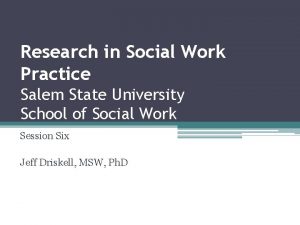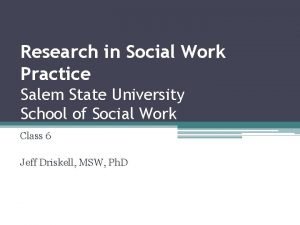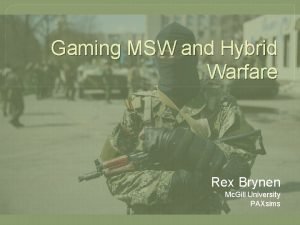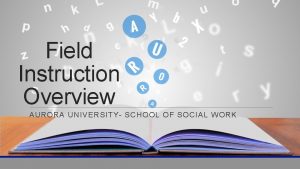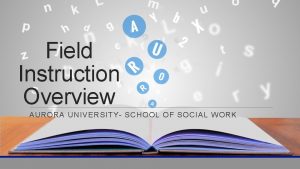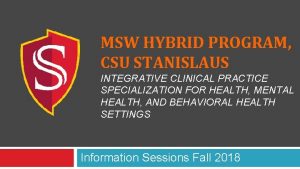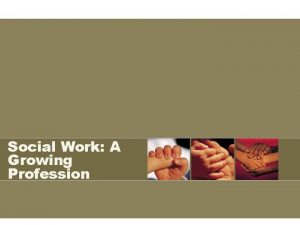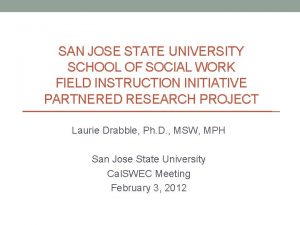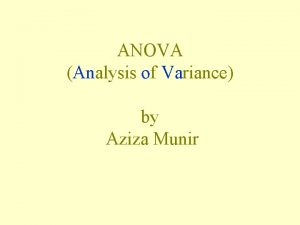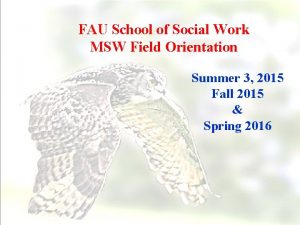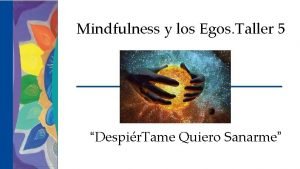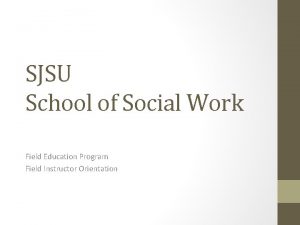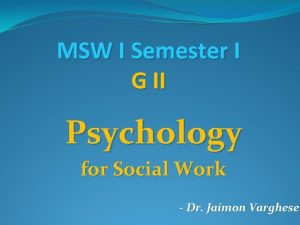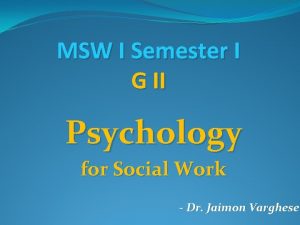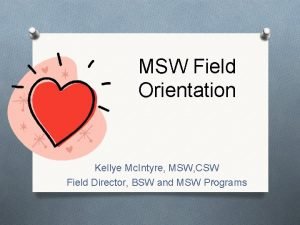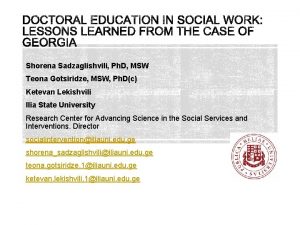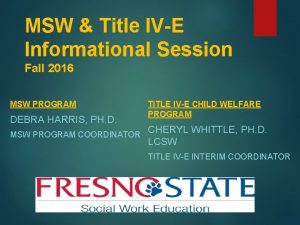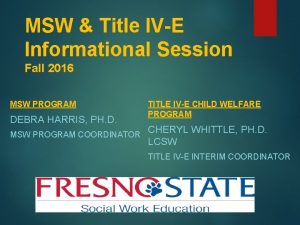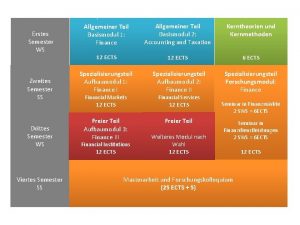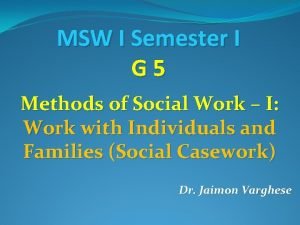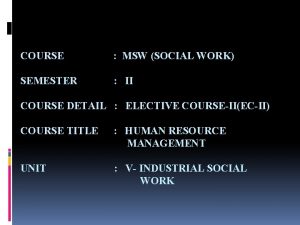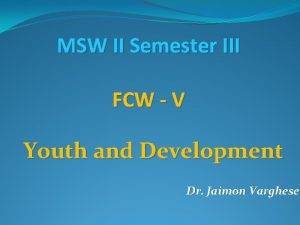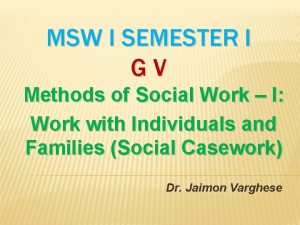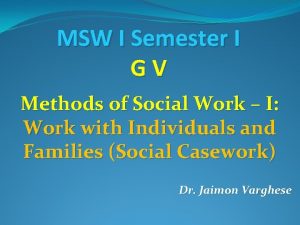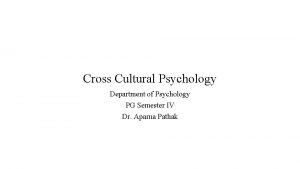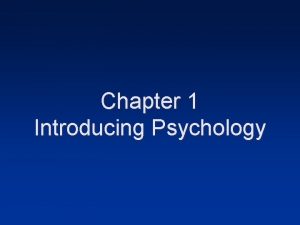MSW I Semester I G IV Psychology for







































































- Slides: 71

MSW I Semester I G IV Psychology for Social Workers - Dr. Jaimon Varghese

2. Human Behaviour 2. 1. Concept of Human Behavior 2. 2 Factors influencing Human behaviour: 2. 2. 1 Heredity, 2. 2. 2 Environment, 2. 2. 3 Intelligence, 2. 2. 4 Needs, 2. 2. 5 Motives 15 -10 -2021 20: 13: 15 Psychology for Social Workers 2

2. Human Behaviour 2. 3. Characteristics, needs, tasks & problems of Stages in life from conception to old age 2. 4. Theories of Human Development 2. 4. 1 Freud’s Psycho- Analytical Theory, 2. 4. 2 Erickson’s Psycho-Social Theory 15 -10 -2021 20: 13: 17 Psychology for Social Workers 3

2. 1. Concept of Human Behaviour • Behavior means any observable action or reaction of a living organism-everything from overt actions (anything we say or do) through subtle changes in the electrical activity occurring deep inside our brains (covert). • If it can be observed and measured, then it fits within the boundaries of psychology. • Similarly, by cognitive processes, psychologists mean every aspect of our mental life-our thoughts, memories, mental images, reasoning, decision making, and so on- in short, all aspects of the human mind 15 -10 -2021 20: 13: 18 Psychology for Social Workers 4

2. 1. Concept of Human Behaviour • Physical (Psychomotor) behaviour • Cognitive (Mental / Intellectual) behaviour • Emotional (affective) behaviour • Social behaviour • Conscious, sub conscious and unconscious behaviour • Verbal and non verbal behaviour • Overt (open) and covert (hidden) behaviour 15 -10 -2021 20: 13: 18 Psychology for Social Workers 5

2. 2 Factors Influencing Human Behaviour 15 -10 -2021 20: 13: 20 2. 2. 1 Heredity, 2. 2. 2 Environment, 2. 2. 3 Intelligence, 2. 2. 4 Needs, 2. 2. 5 Motives Psychology for Social Workers 6

2. 2. 1. Heredity • Biological determinants or genetic features of human development and human behaviour inherited from parents to children and runs through generations • In biology, heredity refers to the genetic transmission of biological characteristics from a parent organism to offspring. • Heredity is the sum of characteristics and associated potentialities transmitted genetically to an individual organism. • Genes are the carriers of biological information. 15 -10 -2021 20: 13: 21 Psychology for Social Workers 7

2. 2. 1. Heredity • High heritability coefficient does NOT mean unchangeable e. g. height and nutrition, or intelligence and environment • Hereditary and genetic influences are two separate mechanisms • Heritability does not address mechanisms of genetic influence • All the hereditary influences (excluding social or cultural inheritance such as religion, mother tongue etc. ) are genetic; however, all the genetic factors are not hereditary (birth abnormalities) 15 -10 -2021 20: 13: 22 Psychology for Social Workers 8

2. 2. 1. Heredity • Human body - human cell – nucleus – 23 pairs of chromosomes (which determines human species) • 23 rd pair of chromosomes (XY) decides the gender of the child • Since Y chromosome is found only in male species, it is the father who decides the gender of the child • The Human Genome: Each gene consists of a set of Deoxyribo Nucleic Acid sequences • Vast majority of our genes are identical, non-identical ones influence variation among people in physical and also some psychological characteristics 15 -10 -2021 20: 13: 23 Psychology for Social Workers 9

2. 2. 1. Heredity • Charles Darwin proposed a theory of evolution in 1859. Darwin believed in a mix of blending inheritance and the inheritance of acquired characteristics. • Francis Galton, who laid the framework for the biometric school of heredity rejected the aspects of Darwin's pangenesis model which relied on acquired characteristics • The idea of particulate inheritance of genes can be attributed to the Austrian monk Gregor Mendel who published on pea plants in 1865 15 -10 -2021 20: 13: 25 Psychology for Social Workers 10

2. 2. 1. Heredity • The law of segregation (Mendel's first law) states that in the process of the formation of the gametes the pairs separate, one going to each gamete, and that each gene remains completely uninfluenced by the other. • The law of independent assortment (Mendel's second law) states that characteristics are inherited independently of each other; e. g. , the dominant trait of yellow seed color in pea plants can appear in combination with either the dominant trait of plant tallness or the recessive trait of dwarfness. 15 -10 -2021 20: 13: 25 Psychology for Social Workers 11

2. 2. 1. • Heredity Mendel found that when a pure strain of peas bearing one form of a gene (that is, a strain in which both members of the gene pair being studied are the same), inbred for many generations, was crossed with a pure strain carrying an alternative form of the gene, one of these forms consistently prevailed over the other in determining the visible characteristics of the offspring; he therefore termed the two forms dominant and recessive, and called the phenomenon itself the law of dominance. 15 -10 -2021 20: 13: 27 Psychology for Social Workers 12

2. 2. 1. Heredity • Height, body structure, colour of skin, hair and eyes, colour blindness, • HIV • Intelligence (arithmetic and linguistic), aesthetics (music, arts, crafts and sports), susceptibility to illness (AIDS, asthma, depression and psychoses like schizophrenia) and temperament (partially) • Certain human characteristics are genetic, but not hereditary: gender (male or female), mental retardation, corollary abnormalities, mono zygotic twins, physical disabilities (physical, visual, hearing or speech impairment and cerebral palsy) and several other physical disorders 15 -10 -2021 20: 13: 28 Psychology for Social Workers 13

2. 2. 1. Heredity • Studies on extraversion and neuroticism show moderate genetic influence • Similarly emotionality (intensity and type), sociability and activity level (intensity and tempo) have also some degree of genetic influence • Genetic component is found for shyness and empathy • Some genetic component for attitudes and beliefs, particularly traditionalism. • Aggressive and altruistic tendencies are moderately hereditary (Mono Zygotic twins more similar than Di-Zygotic twins) 15 -10 -2021 20: 13: 28 Psychology for Social Workers 14

2. 2. 1. Heredity • No genetic influence is there on character, illness like cancer, leprosy, diabetes, corollary diseases, mental retardation (genetic, but not hereditary), alcoholism, morality, religious behaviour, language (mother tongue), culture (culture is social inheritance), knowledge and social skills (leadership, management, romantic love) • Heredity is an important influence, but not near 100%, on personality • Non-genetic influences are clearly and equally important in personality • Heredity and Environment INTERACT prior to any human behaviour 15 -10 -2021 20: 13: 29 Psychology for Social Workers 15

2. 2. 2. • Environment One of the assumptions of behaviourist thought is that behaviour is determined not by heredity but by the environment either through association (conditioning), reinforcement (reward & punishment), imitation, observation, modelling, behaviour modification and learning. 15 -10 -2021 20: 13: 30 Psychology for Social Workers 16

2. 2. 2. Environment • Prenatal environment: malnutrition, medication, injuries • Childbirth: oxygen, birth disorders (injuries) • Post natal environment: malnutrition, immunisation, medication, illness • Physical environment (geographical and climatic features) • Social, political and economic environment 15 -10 -2021 20: 13: 31 Psychology for Social Workers 17

2. 2. 2. Environment • Early childhood and family environment: siblings, peers, care givers (parents, grand parents, significant elders) • School environment • Occupational environment • Marriage and in laws’ home environment 15 -10 -2021 20: 13: 33 Psychology for Social Workers 18

2. 2. 2. Environment • Neighbourhood, school, occupational, institutional (kinship, religion, organisational and political) environment and their influence in affecting human development and moulding human personality • Social roles, status, social competence and leadership • Social perception, cultural and ethnic prejudices, stereotyping and personality development • Mass and crowd behaviour • Group dynamics 15 -10 -2021 20: 13: 33 Psychology for Social Workers 19

2. 2. 2. Environment • Rumour, propaganda, lobbying and advocacy • Social action and social movements: campaigning, self help group • Reformation, revolution and community organisation • Values, norms and culture to shape human personality • Poverty, unemployment and illiteracy their impact on personality development 15 -10 -2021 20: 13: 34 Psychology for Social Workers 20

2. 2. 2. Environment • Political influences, party politics, political crises, political movements, civil war and terrorism and their impact on personality development • Urbanisation, corruption and crimes and their impact on personality • Globalisation, migration, cosmopolitan culture and inter caste marriages and their impact 15 -10 -2021 20: 13: 35 Psychology for Social Workers 21

2. 2. 2. Environment • Economic conditions of the state, region and neighbourhood and their impact on personality • Stress and burnout: loss of loved ones, loss of employment, marital disputes, financial crisis, over work, compassion fatigue 15 -10 -2021 20: 13: 35 Psychology for Social Workers 22

2. 2. 2. Environment • Natural and man made material environment • Scarcity of natural resources • Environmental and ecological factors: pollution (air, water, soil and noise) • Geographical, climatic and economic (infra structure) environment • Natural disasters and calamities and their impact on personality 15 -10 -2021 20: 13: 36 Psychology for Social Workers 23

2. 2. 2. Environment • Housing conditions (home, school, factory, shop and office) • Space, congestion, over crowding, squatter dwellings and slums • Road, transportation and communication facilities of the region, village and neighbourhood • Advanced scientific knowledge and corresponding civic amenities: central locking, theft alarm, automatic doors and water taps (with infrared sensing technology), locks with chip technology (i-cats), 15 -10 -2021 20: 13: 36 Psychology for Social Workers 24

2. 2. 2. Environment • Technology: computer, internet, super sonic transportation, modern medical and diagnostic machinery, mass media and communication environment: mobile phone (3 G) • Distance and travel to work place • Work environment and fatigue: light, sound, fresh air, heat, air conditioning, toilet and drinking water facilities 15 -10 -2021 20: 13: 38 Psychology for Social Workers 25

2. 2. 2. Environment • Child rearing practices • Gender typing (gender roles) • Educational, occupational and social status of the parents and family • Family traditions (traditional occupations) • Class and caste of the family • Marital disputes: misunderstandings, mistrust, legal disputes, dowry disputes 15 -10 -2021 20: 13: 39 Psychology for Social Workers 26

2. 2. 2. Environment • Domestic violence • Divorce and issues of child care • Number of children / lack of children / adopted children • Indiscipline, truancy and running away • Presence of dependent members: persons with disabilities, infants, the elderly, the sick, the incurables • Fatal sickness: cancer 15 -10 -2021 20: 13: 39 Psychology for Social Workers 27

2. 2. 2. Environment • Medical treatment and financial crises • Destitution • Drug addiction • Alcoholism of the chief earning members • Working parents • Role performance: Under achievement of children • Family crises: failure in the performance of family duties 15 -10 -2021 20: 13: 40 Psychology for Social Workers 28

2. 2. 2. Environment • Dissatisfaction and frustration in family life of the couples: issues related to impotency and infertility • Loss of family members 15 -10 -2021 20: 13: 41 Psychology for Social Workers 29

2. 2. 3. Intelligence • Intelligence is a significant factor of behaviour • Intelligence is not satisfactorily defined; it is a combination of abilities and competencies • Intelligence is the ability to learn (IQ); emotional competence (EQ); social competence (leadership); organisational ability (administration and management); spiritual and charismatic quality (ability to move people); artistic aptitudes, sports and crafts abilities; mechanical aptitudes (workmanship); ability for achievement (business); life skills 15 -10 -2021 20: 13: 43 Psychology for Social Workers 30

2. 2. 3. Intelligence • IQ Test measures mainly arithmetic, logical and linguistic abilities that are suitable for learning; lower IQ does not mean that the person is socially, artistically, or spiritually incompetent • Learning disabilities or learning abilities do not have any relationship with the life skills which explains why intellectually superior people sometimes fail in real life while people with average intelligence succeed in life • Intelligence is normally distributed with majority in the average and a few in the bright or dull group • IQ increases by age till 16 -25 yrs, then stops vertically but expands horizontally with experience 15 -10 -2021 20: 13: 44 Psychology for Social Workers 31

2. 2. 3. Intelligence • Intelligence means intellect put to use. It is the use of intellectual abilities for handling a situation or accomplishing any task (Woodworth & Marquis, 1948) • Intelligence is a general capacity of an individual consciously to adjust his thinking to new requirements. It is general mental adaptability to new problems and conditions of life (Stern, 1914) • Intelligence is the capacity to learn and adjust to relatively new and changing conditions (Wagnon, 1937) 15 -10 -2021 20: 13: 45 Psychology for Social Workers 32

2. 2. 3. Intelligence • Intelligence is the power of good responses from the point of truth or fact (Thorndike, 1914) • Intelligence is the aggregate or global capacity of an individual to act purposefully, to think rationally, and to deal effectively with his environment (Wechsler, 1944) • Intelligence is the ability to undertake activities that are difficult, complex and abstract and which are adaptive to a goal, and are done quickly and which have social value and which lead to creation of something new and different (Stoddard, 1943) 15 -10 -2021 20: 13: 46 Psychology for Social Workers 33

2. 2. 3. • Intelligence may be regarded as a sort of mental energy in the form of mental or cognitive abilities available with an individual to enable him to handle his environment in terms of adaptation and facing novel situations as effectively as possible (Mangal SK, 1998: 221) 15 -10 -2021 20: 13: 47 Psychology for Social Workers 34

2. 2. 3. Intelligence 1. Unitary theory or monarchic theory (outdated) 2. Anarchic theory or multifactor theory (EL Thorndike) also named atomistic theory considers intelligence a combination of numerous separate elements of factors, each one being a minute element of an ability. 3. Two factor theory of Spearman: Every different intellectual activity involves a general factor ‘g’ which is shared with all intellectual activities and a specific factor ‘s’ which it shares with none. 15 -10 -2021 20: 13: 48 Psychology for Social Workers 35

2. 2. 3. Intelligence 4. Group factor theory (Thurstone): 9 factors: Verbal (V), Spatial (S), Numerical (N), Memory (M), Word Fluency (W), Inductive Reasoning (RI), Deductive Reasoning (RD), Perceptual (P), and Problem solving (PS) 5. Hierarchical Theory of Vernon (1950): ‘G’ is the most prominent mental ability measured through IQ tests. Under ‘G’, there are two main types of mental abilities, first being ‘Ved’ – Verbal, Numerical and Educational abilities and the second being ‘KM’ – practical, mechanical, spatial and physical abilities. Further each sub type is further divided into minor abilities down the hierarchy 15 -10 -2021 20: 13: 49 Psychology for Social Workers 36

2. 2. 3. 6. Intelligence In Guilford's Structure of Intellect (SI) theory, intelligence is viewed as comprising operations, contents, and products. There are 5 kinds of operations (cognition, memory, divergent production, convergent production, evaluation), 6 kinds of products (units, classes, relations, systems, transformations, and implications), and 5 kinds of contents (visual, auditory, symbolic, semantic, behavioural). Since each of these dimensions is independent, there are theoretically 150 different components of intelligence. 15 -10 -2021 20: 13: 49 Psychology for Social Workers 37

2. 2. 3. Intelligence • Individual test and group tests • Verbal (with language content) and non verbal (performance based or spatial / logical / pictorial content) tests • Individual verbal IQ test: Stanford Binet Test (1960): first developed by French psychologists, Alfred Binet and Theodore Simon in 1905 consisting of 30 items like, ‘at age 3 – point out to nose, eyes and mouth; at age 7 – tell what is missing in the unfinished picture’. Adapted and revised in the USA at Stanford University in 1931 (by Terman), 1937 (by Maud A Merril) and finally in 1960 for age groups 2 to 22 years. 15 -10 -2021 20: 13: 51 Psychology for Social Workers 38

2. 2. 3. Intelligence • Alfred Binet IQ Test was adapted to India for the first time in 1922 by Dr CH Rice ‘Hindustani Binet Performance Scale’. Stanford Binet Test has been translated to Hindi as ‘Budhi Pariksha Anooshilan’ by the State Manovigyan Shala of UP • Samanya Budhi Pariksha (part I & II), the Indian adaptation of William Stephenson’s Verbal IQ Test has been prepared by State Bureau of Educational and Vocational Guidance, Gwalior, MP 15 -10 -2021 20: 13: 52 Psychology for Social Workers 39

2. 2. 3. Intelligence 1. Block building or cube construction 2. To fit the blocks in the holes 3. Tracing a maze 4. Picture arrangement or picture completion Popular Performance Tests: 1. The Pinter Patterson Scale, designed in the USA in 1917, a comprehensive test including 17 sub-tests 2. Arthur’s Point Scale having 9 sub tests 3. Alexander’s Battery of Performance Tests (Edinburg): 3 tests – Pass-along, Block designs and cube construction 15 -10 -2021 20: 13: 52 Psychology for Social Workers 40

2. 2. 3. Intelligence 4. Bhatia’s Battery of Performance Tests (Dr. Chander Mohan Bhatia): 5 subsets – Koh’s Block Design Test, Alexander’s Pass-along test, Pattern Drawing Test, Immediate memory test for digits, Picture construction test 5. Wechsler bellevue Intelligence Scale for Children (WISC): both verbal and performance tests: Verbal scale – General Information, General Comprehension, Arithmetic reasoning, distinction between similarities, digit span and vocabulary; Performance scale – Digit & symbol, Picture completion, Block design, Picture arrangement, Object assembly. 15 -10 -2021 20: 13: 53 Psychology for Social Workers 41

2. 2. 3. Intelligence 1. Army Alpha Test (during World War I) 2. Army General Classification Test (World War II) 3. CIE verbal group test of Intelligence (Hindi) (Prof. Uday Shankar) 4. Samuhik Mansik Yogyata Pariksha (Dr. S Jalota) 5. Samuhik Budhi Pariksha (Mansayan, Delhi) 6. Samuhik Budhi Pariksha (Shri PL Shrimali, Vidya Bhavan, Udaipur) 7. Samuhik Budhi Ki Jaanch (Shri SM Mohsin, Edu. & Voc. Guidance Bureau, Patna) 8. General Mental Abilities Test (Punjabi) (Dr. PS Hundal, Punjab University) 9. Group verbal intelligence test (Malayalam) (Dr. P Gopala Pillai, Kerala University) 15 -10 -2021 20: 13: 53 Psychology for Social Workers 42

2. 2. 3. Intelligence 1. Army Beta Test (World War I for the US soldiers who were illiterate or non English speaking) 2. Chicago Non-verbal Test 3. Raven’s Progressive Matrices Test 4. CIE nonverbal group test of intelligence, originally prepared by JW Jenkins, adapted into Hindi medium schools 15 -10 -2021 20: 13: 54 Psychology for Social Workers 43

2. 2. 3. Intelligence • IQ = (MA / CA) x 100 (IQ – Intelligence Quotient; MA – Mental Age; CA – Chronological Age) • IQ remains rather constant throughout the age of a person • Classification of IQ (Udai Shankar, 1984) 0 -25: Custodial 25 -50: Trainable 50 -75: Educable 75 -90: Borderline 90 -110: Average 110 -125: Superior 125 -140: Very superior 15 -10 -2021 20: 13: 55 >140: Genius Psychology for Social Workers 44

2. 2. 4. Needs and Motives • Needs and motives are primary factors of motivated behaviour • Needs are more physiological by origin, while motives are acquired by learning and socialisation; needs are basic and primary while motives are secondary needs • Hunger, thirst, rest, activity, escape from pain and survival are needs while achievement, rewards, knowledge, happiness, satisfaction and contentment are motives 15 -10 -2021 20: 13: 57 Psychology for Social Workers 45

2. 2. 4. Needs and Motives • Needs are innate and motives are learnt • Needs are associated with instincts, impulse and drives; while motives are associated with goals, ideals, objectives, purpose and reason 15 -10 -2021 20: 13: 59 Psychology for Social Workers 46

2. 3. Characteristics, needs, tasks & problems of Stages in life from conception to old age General task for every stage • Achieving a realistic frame of reference • Development of physical, intellectual, emotional and social competencies needed in one’s culture • Learning about and preparing for the problems likely to be encountered in living 15 -10 -2021 20: 14: 00 Psychology for Social Workers 47

2. 3. Characteristics, needs, tasks & problems of Stages in life from conception to old age General task for every stage • Developing and using one’s capacities • Accepting reality and building valid attitudes and values • Participating creatively and responsibly in family and other groups • Building rich linkage with one’s world 15 -10 -2021 20: 14: 02 Psychology for Social Workers 48

2. 3. Characteristics, needs, tasks & problems of Stages in life from conception to old age Developmental needs, tasks and problems (0 -6 yrs) • Learning to walk, crawl, take solid food, talk, control the elimination of body wastes, Learning sex differences and sexual modesty, getting ready to read, forming concepts and learning language to describe social and physical reality. • Sense of trust in self and others • Capacity to give and take affection • Skills in motor coordination 15 -10 -2021 20: 14: 03 Psychology for Social Workers 49

2. 3. Characteristics, needs, tasks & problems of Stages in life (3 Months) • Lift head and shoulders while on stomach • Follow object with eyes, turn head towards light • Grasp rattle; Wiggle and kick • Smile and wiggle for familiar adult or become quiet and interested • Coo, gurgle, repeat sounds made by adult, play peekabooo; Communicate fear, hunger etc by crying or facial expressions • Some reflexes become purposeful like rooting for nipple, sucking, grasping 15 -10 -2021 20: 14: 04 Psychology for Social Workers 50

2. 3. Characteristics, needs, tasks & problems of Stages in life (6 months) • Rolls from stomach to back • Reaches for toy • Transfers toy from one hand to other • Looks for noise made near him or her • Makes sounds for specific reasons (hunger, wet, etc. ) 15 -10 -2021 20: 14: 06 Psychology for Social Workers 51

2. 3. Characteristics, needs, tasks & problems of Stages in life (6 months) • Helps hold bottle while feeding • Plays with toes • Pats mirror image • Puts everything in his or her mouth • Follows toys when held in front of eyes and moved 15 -10 -2021 20: 14: 07 Psychology for Social Workers 52

2. 3. Characteristics, needs, tasks & problems of Stages in life (1 year) • Sits without support • Pulls to stand • Crawls on all fours • Understands "no" and "bye-bye" • Repeats sounds made by others • Feeds self cookies (may not be neat) • Waves bye-bye • Shy with strangers • Turns pages of book (more than one at a time) 15 -10 -2021 20: 14: 08 Psychology for Social Workers 53

2. 3. Characteristics, needs, tasks & problems of Stages in life (2 years) • Walks well • Carries toy while walking • Speaks several understandable words • Refers to self by name • Recognizes self in mirror • Feeds self with spoon (may spill) and drinks from a cup • Occupies self in play; Plays with an adult • Builds a tower of blocks • Points to body parts (eyes, nose, foot) when asked 15 -10 -2021 20: 14: 08 Psychology for Social Workers 54

2. 3. Characteristics, needs, tasks & problems of Stages in life (3 years) • Goes up steps, two feet on a step • Walks on tiptoe; Runs easily; Unwraps candy • Names objects such as toys and food • Speaks in three word sentences, "me go home. " • Pulls off sock as part of undressing • Helps adults by putting away toys and clothes (when asked) • Turns pages one at a time • Recites nursery rhymes, Shows interest in TV and radio 15 -10 -2021 20: 14: 09 Psychology for Social Workers 55

2. 3. Characteristics, needs, tasks & problems of Stages in life (4 years) • Walks up steps, one foot on each step • Picks up small objects easily; Unbuttons • Tells stories; Speaks in complete sentence, "I want a cookie" • Dresses self; Feeds self well • Washes face and hands; Toilet trained • Gets along with other children • Imitates adults doing simple tasks • Builds a tower of 10 blocks • Copies a circle; Matches some objects and colours 15 -10 -2021 20: 14: 09 Psychology for Social Workers 56

2. 3. Characteristics, needs, tasks & problems of Stages in life (5 years) • Hops and skips on one foot; Marches in time • Catches a ball with his or her hands • Speaks clearly and can be understood by others not in the family • Brushes his or her teeth; Cares for all toilet needs • Follows two directions, "go get the ball and throw it to me" • Recognizes shapes; Copies a square, circle, triangle and cross • Recognizes coins; Counts to four 15 -10 -2021 20: 14: 10 Psychology for Social Workers 57

2. 3. Characteristics, needs, tasks & problems of Stages in life (Ages 6 -12) • Learning physical skills necessary for ordinary games • Learning to get along with age mates • Building wholesome attitudes toward oneself as a growing organism • Learning on appropriate masculine or feminine social role • Developing concepts necessary for everyday living • Developing conscience, morality and a scale of values • Achieving personal independence • Developing attitudes toward social groups and institutions 15 -10 -2021 20: 14: 11 Psychology for Social Workers 58

2. 3. Characteristics, needs, tasks & problems of Stages in life (Ages 12 -18) • Concern beyond self; Prepare for occupation • Achieving new and more mature relations with age mates of both sexes • Achieving a masculine or feminine social role • Accepting one’s physique and using the body effectively • Achieving emotional independence of parents and other adults • Preparing for marriage and family life • Acquiring a set of values and an ethical system as a guide to behaviour • Desiring and achieving socially responsible behaviour 15 -10 -2021 20: 14: 13 Psychology for Social Workers 59

2. 3. Characteristics, needs, tasks & problems of Stages in life (Ages 18 -30) • Selecting a mate; Learning to live with a partner • Starting family; Rearing children; Managing home • Getting started in occupation • Taking on civic responsibility • Finding a congenial social group 15 -10 -2021 20: 14: 13 Psychology for Social Workers 60

2. 3. Characteristics, needs, tasks & problems of Stages in life (Ages 30 -60) • Meaning in one’s life; • Civic responsibilities • Manage home; • Congenial social groups • Learning to live with a spouse; • Concern beyond self • Assisting teenage children to become responsible and happy adults 15 -10 -2021 20: 14 Psychology for Social Workers 61

2. 3. Characteristics, needs, tasks & problems of Stages in life (Ages 30 -60) • Achieving adult social and civic responsibility • Reaching and maintaining satisfactory performance in one’s occupational career • Developing adult leisure time activities • Relating oneself to one’s spouse as a person • To accept and adjust to the physiological changes of middle age • Adjusting to aging parents 15 -10 -2021 20: 14 Psychology for Social Workers 62

2. 3. Characteristics, needs, tasks & problems of Stages in life (60 and over) • Adjusting to decreasing physical strength and health • Adjusting to retirement and reduced income • Adjusting to death of a spouse or the beloved • Establishing an explicit affiliation with one’s age group • Adopting and adapting social roles in a flexible way • Establishing satisfactory physical living arrangements 15 -10 -2021 20: 14 Psychology for Social Workers 63

2. 4. Theories of Human Development 2. 4. 1 Freud’s Psycho- Analytical Theory, 2. 4. 2 Erickson’s Psycho-Social Theory 15 -10 -2021 20: 14: 15 Psychology for Social Workers 64

2. 4. 1. Freud’s Psycho-Analytical theory • Personality structure: Id – Ego – Super Ego • In Freudian psychology, each child passes through five psychosexual stages. • During each stage, the id focuses on a distinct erogenous zone on the body. • According to Freud, suffering from trauma during any of the first three stages may result in fixation. • Freud related the resolutions of the stages with adult personalities and personality disorders. 15 -10 -2021 20: 14: 16 Psychology for Social Workers 65

2. 4. 1. Freud’s Psycho-Analytical theory Stage Age Range Erogenous zone(s) Consequences of Fixation Oral 0 -18 months Mouth Passive dependence or excessive smoking / eating Anal 18 -36 months Bowel and bladder elimination Lack of organization or excessive neatness Phallic 3 -6 years Genitals Oedipus complex (in boys only according to Freud) Latency 6 years-puberty Genital Puberty and beyond 15 -10 -2021 20: 14: 18 Dormant sexual feelings Sexual interests mature Psychology for Social Workers No fixation 66

2. 4. 2. Erickson’s psycho-social theory • Erikson describes eight developmental stages through which a healthily developing human should pass from infancy to late adulthood. • In each stage the person confronts, and hopefully masters, new challenges. • Each stage builds on the successful completion of earlier stages. • The challenges of stages not successfully completed may be expected to reappear as problems in the future. 15 -10 -2021 20: 14: 18 Psychology for Social Workers 67

2. 4. 2. Erickson’s psycho-social theory Significant relations Psychosocial modalities Infant trust mistrust mother to get, to give in return 2 -3 Toddler autonomy shame and doubt parents 3 -6 Preschooler initiative – guilt family Age 0 -1 Age group Psychosocial crisis 15 -10 -2021 20: 14: 19 Psychosocial virtues Maladaptations / malignancies hope, faith sensory distortion, withdrawal to hold on, will, to let go determination to go after, to play Psychology for Social Workers purpose, courage impulsivity, compulsion ruthlessness, inhibition 68

2. 4. 2. Age group School 7 -12 age child Erickson’s psycho-social theory Psychosocial crisis Significant relations industry – inferiority to complete, neighbourh to make ood and things school together 1218 Adolescent ego-identity - roleconfusion 1845 Young adult intimacy – isolation 15 -10 -2021 20: 14: 24 Psychosocial modalities peer groups, role models to be oneself, to share oneself partners, friends to lose and find oneself in another Psychology for Social Workers Psychosocial virtues Maladaptations / malignancies competence narrow virtuosity, inertia fidelity, loyalty fanaticism, repudiation love promiscuity, exclusivity 69

2. 4. 2. Erickson’s psycho-social theory Age group Psychosocial crisis 3065 Middle aged adult generativity - selfabsorption 50+ Old adult integrity – despair 15 -10 -2021 20: 14: 25 Significant relations Psycho. Mal. Psycho-social adaptations / modalities virtues malignancies household, co-workers to make actual, to take care of care overextension, rejectivity mankind or 'my kind' to be, through having been, to face not being wisdom presumption, despair Psychology for Social Workers 70

Thank You 15 -10 -2021 20: 14: 26 Psychology for Social Workers 71
 Montemarta
Montemarta Salem state university social work
Salem state university social work Salem state msw
Salem state msw Msw tourniquet
Msw tourniquet Uwf msw
Uwf msw Csustan msw
Csustan msw Msw vtmis
Msw vtmis Csumb
Csumb Msw online gaming
Msw online gaming Programiranje logo
Programiranje logo Msw logo turtle
Msw logo turtle Western michigan university msw
Western michigan university msw Ut arlington msw
Ut arlington msw Aurora university msw
Aurora university msw Msw apes
Msw apes University of memphis school of social work
University of memphis school of social work A flat fee pricing system for msw services
A flat fee pricing system for msw services Ucsf warn me
Ucsf warn me Kako se crta pravokutni trokut
Kako se crta pravokutni trokut Aurora university msw
Aurora university msw Csu stanislaus msw
Csu stanislaus msw Msw rhossili
Msw rhossili Msw scholarships 2019
Msw scholarships 2019 Msw
Msw San jose state social work
San jose state social work Edall button in msw logo
Edall button in msw logo F=msb/msw
F=msb/msw Aka.msw
Aka.msw Fau field placement
Fau field placement Conjunción oposición cuadratura trigono sextil
Conjunción oposición cuadratura trigono sextil Sjsu school of social work
Sjsu school of social work Etik och ledarskap etisk kod för chefer
Etik och ledarskap etisk kod för chefer Frgar
Frgar Teckenspråk minoritetsspråk argument
Teckenspråk minoritetsspråk argument Indikation för kejsarsnitt på moderns önskan
Indikation för kejsarsnitt på moderns önskan Datorkunskap för nybörjare
Datorkunskap för nybörjare Toppslätskivling dos
Toppslätskivling dos Returpilarna
Returpilarna Steg för steg rita
Steg för steg rita Redogör för vad psykologi är
Redogör för vad psykologi är Ramsa geometriska former
Ramsa geometriska former Claes martinsson
Claes martinsson Publik sektor
Publik sektor Olika rim dikter
Olika rim dikter Tidbok yrkesförare
Tidbok yrkesförare Klädsel i rom
Klädsel i rom Kontinuitetshantering
Kontinuitetshantering Orubbliga rättigheter
Orubbliga rättigheter Verktyg för automatisering av utbetalningar
Verktyg för automatisering av utbetalningar Ministerstyre för och nackdelar
Ministerstyre för och nackdelar Jätte råtta
Jätte råtta Vem räknas som jude
Vem räknas som jude Tillitsbaserad ledning
Tillitsbaserad ledning Nyckelkompetenser för livslångt lärande
Nyckelkompetenser för livslångt lärande Sju för caesar
Sju för caesar Tack för att ni lyssnade bild
Tack för att ni lyssnade bild Vad är verksamhetsanalys
Vad är verksamhetsanalys Mästar lärling modellen
Mästar lärling modellen Shingelfrisyren
Shingelfrisyren Matematisk modellering eksempel
Matematisk modellering eksempel Shivaismen
Shivaismen Cks
Cks Aktiv exspektans
Aktiv exspektans Jag har nigit för nymånens skära
Jag har nigit för nymånens skära Inköpsprocessen steg för steg
Inköpsprocessen steg för steg Strategi för svensk viltförvaltning
Strategi för svensk viltförvaltning A gastrica
A gastrica Novell typiska drag
Novell typiska drag Stickprovsvarians
Stickprovsvarians Tack för att ni har lyssnat
Tack för att ni har lyssnat Treserva lathund
Treserva lathund Läkarutlåtande för livränta
Läkarutlåtande för livränta

